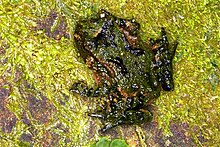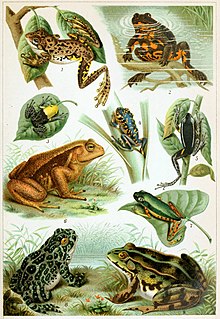Portal:Amphibians
The Amphibian Portal
Amphibians are ectothermic, anamniotic, four-limbed vertebrate animals that constitute the class Amphibia. In its broadest sense, it is a paraphyletic group encompassing all tetrapods excluding the amniotes (tetrapods with an amniotic membrane, such as modern reptiles, birds and mammals). All extant (living) amphibians belong to the monophyletic subclass Lissamphibia, with three living orders: Anura (frogs and toads), Urodela (salamanders), and Gymnophiona (caecilians). Evolved to be mostly semiaquatic, amphibians have adapted to inhabit a wide variety of habitats, with most species living in freshwater, wetland or terrestrial ecosystems (such as riparian woodland, fossorial and even arboreal habitats). Their life cycle typically starts out as aquatic larvae with gills known as tadpoles, but some species have developed behavioural adaptations to bypass this.
Young amphibians generally undergo metamorphosis from an aquatic larval form with gills to an air-breathing adult form with lungs. Amphibians use their skin as a secondary respiratory interface and some small terrestrial salamanders and frogs lack lungs and rely entirely on their skin. They are superficially similar to reptiles like lizards, but unlike reptiles and other amniotes, require access to water bodies to breed. With their complex reproductive needs and permeable skins, amphibians are often ecological indicators to habitat conditions; in recent decades there has been a dramatic decline in amphibian populations for many species around the globe.
The earliest amphibians evolved in the Devonian period from tetrapodomorph sarcopterygians (lobe-finned fish with articulated limb-like fins) that evolved primitive lungs, which were helpful in adapting to dry land. They diversified and became ecologically dominant during the Carboniferous and Permian periods, but were later displaced in terrestrial environments by early reptiles and basal synapsids (predecessors of mammals). The origin of modern lissamphibians, which first appeared during the Early Triassic, around 250 million years ago, has long been contentious. The most popular hypothesis is that they likely originated from temnospondyls, the most diverse group of prehistoric amphibians, during the Permian period. Another hypothesis is that they emerged from lepospondyls. A fourth group of lissamphibians, the Albanerpetontidae, became extinct around 2 million years ago. (Full article...)
Selected frog article
Archaeobatrachia (Neo-Latin archaeo- ("old") + batrachia ("frog")) is a suborder of the order Anura containing various primitive frogs and toads. As the name suggests, these are the most primitive frogs. Many of the species (28 in total) show certain physiological characteristics which are not present in other frogs and toads, thus giving rise to this group. They are largely found in Eurasia, New Zealand, the Philippines, and Borneo, and are characteristically small. In addition, the family Ascaphidae is found in the Pacific Northwest and northern Rocky Mountains of the United States, and is only represented by two species. The taxon is considered paraphyletic. (Full article...)
Selected salamander article
The Caudata are a group of amphibians containing the extant salamanders (the order Urodela) and all extinct species of amphibians more closely related to salamanders than to frogs. They are typically characterized by a superficially lizard-like appearance, with slender bodies, blunt snouts, short limbs projecting at right angles to the body, and the presence of a tail in both larvae and adults.
Disagreement exists between different authorities as to the definition of the terms "Caudata" and "Urodela". Some maintain that Urodela should be restricted to the crown group, with Caudata being used for the total group. Others restrict the name Caudata to the crown group and use Urodela for the total group. The former approach seems to be most widely adopted and is used in this article. (Full article...)
List of selected salamander articles
|
|---|
Did you know? –

- ... that Lehmann's poison frog is not toxic in captivity because its poison derives from food it eats only in the wild?
- ... that the Brazil-nut poison frog (pictured) sometimes places its tadpoles in water-filled capsules that have fallen from the Brazil nut tree?
- ... that female gregarious slender salamanders often lay their eggs in communal nests?
- ... that toads found in Egypt around 1909 and identified as Degen's toad are now considered a separate species, the Nile Delta toad?
- ... that the recently named trematopid temnospondyl Fedexia was named after the shipping service FedEx, which owned the land where the holotype specimen was found?
Selected amphibian type
A frog is any member of a diverse and largely carnivorous group of short-bodied, tailless amphibians composing the order Anura (coming from the Ancient Greek ἀνούρα, literally 'without tail'). The oldest fossil "proto-frog" Triadobatrachus is known from the Early Triassic of Madagascar (250 million years ago), but molecular clock dating suggests their split from other amphibians may extend further back to the Permian, 265 million years ago. Frogs are widely distributed, ranging from the tropics to subarctic regions, but the greatest concentration of species diversity is in tropical rainforest. Frogs account for around 88% of extant amphibian species. They are also one of the five most diverse vertebrate orders. Warty frog species tend to be called toads, but the distinction between frogs and toads is informal, not from taxonomy or evolutionary history.
An adult frog has a stout body, protruding eyes, anteriorly-attached tongue, limbs folded underneath, and no tail (the tail of tailed frogs is an extension of the male cloaca). Frogs have glandular skin, with secretions ranging from distasteful to toxic. Their skin varies in colour from well-camouflaged dappled brown, grey and green to vivid patterns of bright red or yellow and black to show toxicity and ward off predators. Adult frogs live in fresh water and on dry land; some species are adapted for living underground or in trees.
Frogs typically lay their eggs in the water. The eggs hatch into aquatic larvae called tadpoles that have tails and internal gills. They have highly specialised rasping mouth parts suitable for herbivorous, omnivorous or planktivorous diets. The life cycle is completed when they metamorphose into adults. A few species deposit eggs on land or bypass the tadpole stage. Adult frogs generally have a carnivorous diet consisting of small invertebrates, but omnivorous species exist and a few feed on plant matter. Frog skin has a rich microbiome which is important to their health. Frogs are extremely efficient at converting what they eat into body mass. They are an important food source for predators and part of the food web dynamics of many of the world's ecosystems. The skin is semi-permeable, making them susceptible to dehydration, so they either live in moist places or have special adaptations to deal with dry habitats. Frogs produce a wide range of vocalisations, particularly in their breeding season, and exhibit many different kinds of complex behaviors to attract mates, to fend off predators and to generally survive. (Full article...)
List of selected amphibian type articles
|
|---|
Selected images
Selected toad article

The bleeding toad, fire toad or Indonesian tree toad (Leptophryne cruentata) is a species of true toad in the amphibian family Bufonidae, endemic to Java, Indonesia. L. javanica was, formerly, synonymous with the bleeding toad prior to its description as a distinct species in 2018, although the degree of differentiation between these species is low. The bleeding toad is listed as a critically endangered species due to a drastic population decline. The factors behind this decline are unclear, but appear consistent (despite ambiguous observations) with the global spread of chytrid fungus, a particularly lethal fungal spore for frogs and toads; once infected, the animals develop a condition known as chytridiomycosis before ultimately dying. it is estimated there are less than 250 individuals of the species. (Full article...)
Selected caecilian article

Chikila is a genus of amphibian in the order Gymnophiona (caecilians). It is the only genus within the family Chikilidae. All members of the genus are known from northeast India and Bangladesh. (Full article...)
Need help?
Do you have a question about Amphibians that you can't find the answer to?
Consider asking it at the Wikipedia reference desk.
Topics
Subcategories
Related portals
Associated Wikimedia
The following Wikimedia Foundation sister projects provide more on this subject:
-
Commons
Free media repository -
Wikibooks
Free textbooks and manuals -
Wikidata
Free knowledge base -
Wikinews
Free-content news -
Wikiquote
Collection of quotations -
Wikisource
Free-content library -
Wikiversity
Free learning tools -
Wiktionary
Dictionary and thesaurus










































